Fourteen Wireless Speakers, an iPhone 6, and 188 Stamps
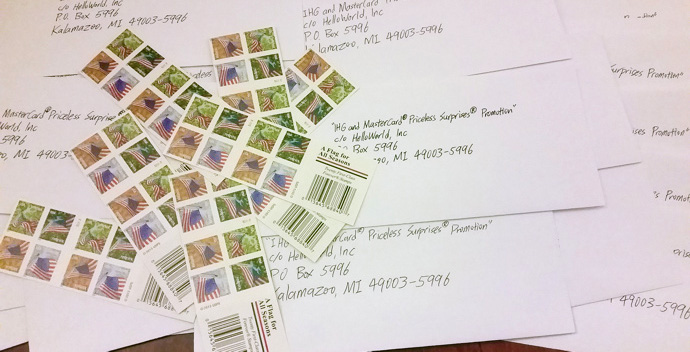
The world of credit cards and travel hacking has a lot of low-hanging fruits, where handfuls of points and miles can be had for low or no cost. Like stocks and careers, though, sometimes the bigger rewards require larger, riskier investments. 2015 was a year when I learned about – and participated in – some of these opportunities. From extreme couponing to free points hoarding, I had a lot of fun with them. Three of my fondest memories are recounted below.
1. FOURTEEN WIRELESS SPEAKERS
Last summer, I learned that it was possible to get 70%+ off when shopping at Sears.com. The ultimate quintuple dipping worked like this:
- Buy gift cards online via portal. Discover IT had Q3 5% on Sears.com, and Discover Deals paid out 10% at the time.
- Use gift cards to buy promotional items that returned 100% in Shop Your Way (SYW) points, i.e. you virtually get them for free. Going through Discover Deals again paid another 10%.
- Use the SYW points to buy the actual merchandise desired. Going through Discover Deals paid the third 10%.
- With Discover’s double-points promotion currently in place, the expected total payout was 2x(5%+10%+10%+10%) = 70%.
Note that it is no longer possible to fully replicate such a sweet deal as of now, but some components of the strategy remain and others may return periodically. To learn more about everything Sears, read Frequent Miler’s posts here, here, here, and here.
For the first two decades that I lived in this country, Sears had been the part of malls that, not unlike the parking lot, I had to walk through and never had a reason to stop in. The prospect of getting 70% off stuff suddenly put it on my list of “preferred” stores. For a few weeks, I worked hard to come up with ideas of things to buy. Eventually, I bought a $400 robot vacuum (Neato Signature XV) using these techniques. The process of acquiring it was not for the faint of heart.
The minimum requirement for maximizing at Sears was (1) having a Discover card, (2) having activated the quarterly 5% bonus, and (3) having a SYW account. From there, step 3 only works on items sold by Sears, which can be a very small fraction of the Marketplace items listed on the Sears website. In addition, many Sears items are 30-40% marked up over what you can find on Amazon, so it can be tricky to find something for your efforts to yield a meaningful discount. Also, to take full advantage of these deals there needs to be at least one SYW promotional item giving 100% back in points (that is available in your area), and such promotions don’t come that often.
When all the stars aligned was also when the risky aspects of this game began: buying a gift card was time consuming because Sears’s fraud prevention took its job a little too seriously. Discover Deals encountered IT issues and was unavailable from time to time. While waiting for either of those, the promotional item and what I actually wanted to buy were at risk of selling out. The SYW points earned expired quickly, leaving me a small window to make use of them. Lastly, because shopping portals did not always pay out as anticipated, a heavy reliance on them was akin to having a lot of eggs in a single basket. Believe it or not, in my attempt to purchase a single vacuum, I encountered nearly all of these problems and had a few mini heart attacks…
In the end, though, everything worked out. My vacuum was $436 after tax. I have received $140 in cash back (some of which was through eBates when Discover Deals was down), and I expect another $132 in cash back when Discover pays out the double points. At the end of the day, my expenditure would be about $164, less than 38% of the full cost.
And that’s not even counting the 14 Bluetooth wireless devices that I got as promotional items in step 3: 11 large speakers, 1 small speaker, and 2 headsets. Giving them away to friends and coworkers was fun, but explaining how I acquired them at a negative cost always got me some awkward stares.
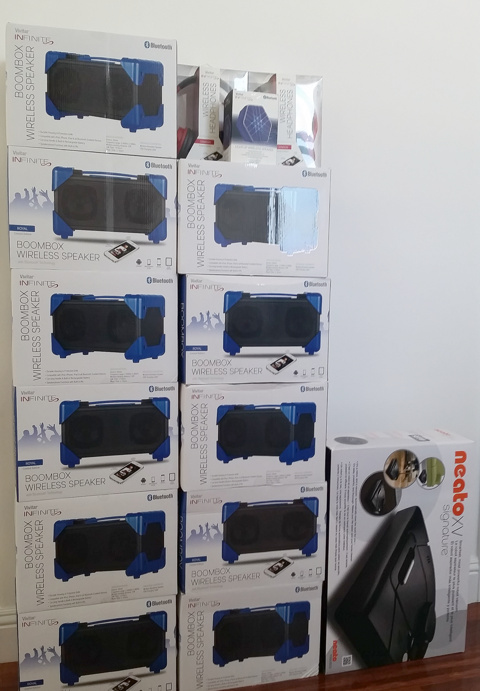
What I purchased (right) and the collateral damage (left)
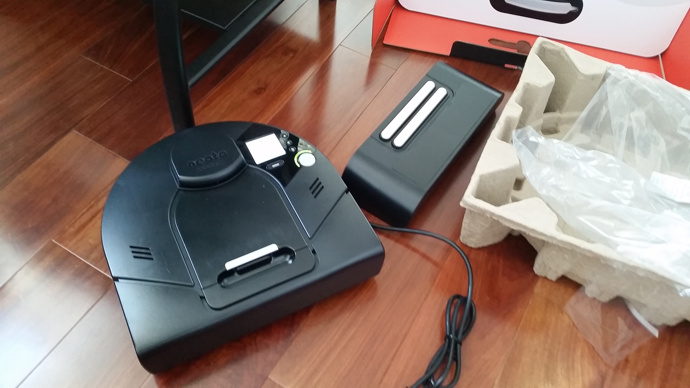
For those who care to know, the Neato robot vacuum was my best purchase of the year because of how much house work it had saved me.
Verdict: win
2. AN IPHONE 6
Discover was having a serious year of promotions. In early September, its partnership with Apple Pay announced what seemed like the biggest free money opportunity ever – 10% back on every purchase, made on a Discover card via Apple Pay. Limited to $10,000 in purchases per Discover card, this promotion was in addition to the base cash back from the card itself. Better yet, it also stacked with the double cash back promotion, bringing the total earning rate to 22% for Discover IT and 23% for Discover IT Miles.
I figured that rewards would still be ridiculously rich, even if I manufactured spend in the least cost-effective way possible:
- Buy 40 $500 VISA gift cards between my two Discover accounts. Fees = $5.95 x 40 = $238
- Liquidate the gift cards via Plastiq to pay mortgage at a 2.5% fee. Fees = $500
- Total cash back = 2x($20,000 x 10% + $10,119 x 1% + $10,119 x 1.5%) = $4,506
- Net earning = $3,768
The “earning” would be even sweeter if I spent part of the $20k allowance on stuff that I actually would buy, like Big Mac and M&M’s. I sincerely planned to become $4,000 richer before the holidays. One last problem to solve? I didn’t have the right phone.
I used a Samsung Galaxy S5 as my personal phone, and had an iPhone 5S from work. In order to use Apple Pay with Discover, I needed an iPhone 6 or newer running iOS 9. Was it a big deal? Well yes and no. Current-generation smartphones are mad expensive, and are usually not a spur-of-the-moment kind of purchase. However, when $4,000 was on the table, several hundred dollars was not a terrible investment, right? I went on Amazon and spent just under $450 for a used iPhone 6. It was, by far, the largest bet that I had placed on any points-related activity. The potential reward was undeniably amazing, but deep down I realized that I was gambling / experimenting with some assumptions.
Before my used iPhone 6 even arrived in the mail, Discover added to their promotion terms: “excludes gift cards.” That was vague enough, but they kicked where it hurt. There was an uproar against Discover’s bait-and-switch style marketing. People came up with lots of theories around how the credit card issuer couldn’t possibly enforce this rule, and speculations on whether it actually would. I remained optimistic and carried on with my plan.
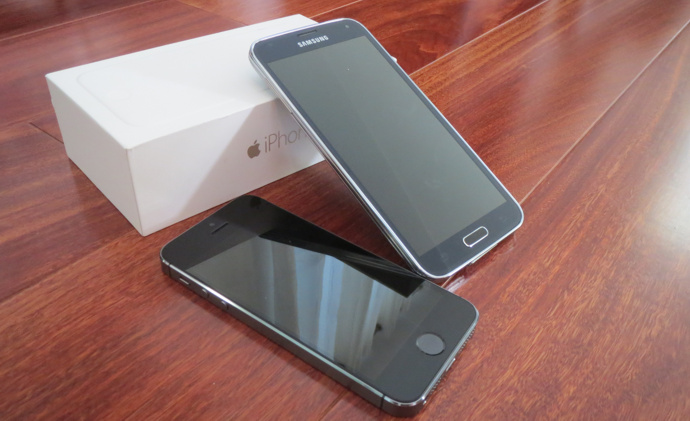
For three months, I carried three phones on me. More precisely, one of them was a credit card holder that happened to also take excellent pictures
My hoped dimmed, and then shattered, after charging over $10,000 between the two Discover cards. Turned out that Discover took a heavy handed approach in making a blanket guesses on which purchases contained gift cards, marking them as ineligible for the promotion, and making it the customers’ burden to prove otherwise. Despite my creative efforts to buy gift cards of random amounts (like $479.83), none of them survived the onslaught. The online community suggested all sorts of ideas to outsmart Discover, with no avail. I was losing my bet on the iPhone purchase. While I was unhappy about it, it was fair for Discover to close loopholes and prevent abuse. I took a known risk, and had no one but myself to blame for the outcome.
Things took a positive turn as I made several unexpected large purchases through the promotion, so the total cash back covered the cost of the phone. I also ended up making a little bit of money on the device itself, after a series of rather unexpected events. This entire journey resulted in a net profit for me, though not according to plans and not necessarily replicable in a parallel universe. I consider myself having lucked out; but in the attempt to hack this promotion, Discover sure one-upped me.
Verdict: fail, but not a total face plant
3. 188 STAMPS
November presented an incredible deal known as the IHG and MasterCard Priceless Surprises Promotion. It was a sweepstakes-styled game with game pieces awarded to customers who met certain stay requirements. In order to not be governed by gambling laws, though, the promotion included a standard “no purchase necessary” provision, where anyone could write in to request game pieces.
According to published rules, each game piece would award a minimum of 500 points. Unlike your 32nd piece of Readings Railroad in the McDonald’s Monopoly, incremental 500 points could be a few dollars in value. The best thing about this promotion was that each person was allowed up to 94 entries. Even if each entry returned the minimum prize of 500 points, the total winning of 47,000 was borderline enough (at the time) for one night at the best InterContinental hotel in the world.
Some might argue that there are easier and less labor-intensive ways to get points. Sure. The Chase IHG card had 80,000-point sign up bonuses from time to time, and can be had after 10 minutes of work. However, for those who prefer no credit inquiry, no minimum spend requirement, or would not be eligible for a new Chase card, IHG points really don’t come any cheaper than this.
Unlike the first two opportunities, there was no risk here of losing much money. The investment of time and effort, though, was no joke. We had to hand-write our requests, one entry per envelope. When including addressing the envelope, I averaged a little more than 3 minutes per request. And I did not stop at 94… to maximize, I enrolled my wife in the promotion and wrote all her share, too. The 188 index cards and envelopes took me 10 hours to complete. My hand had not been this cramped since my last FSA exam in 2008.

Combining all my pen pals, holiday cards, bills, rebates, and tax returns my entire life, I don’t think I had put this many envelopes in the mailbox. This promotion was keeping USPS in business!
So far, my wife and I have gotten back 186 game pieces from the 188 entries. I’m happily writing off the remaining two as lost in the process – judging from my experience with post cards, a mere 1% loss rate is already incredible. Our combined winnings are 105,000 IHG points plus $150 in virtual MasterCard gift cards, which I conservatively estimate to be worth $650. The monetary investment was $92.12 in stamps (which I bought at Walgreens using Apple Pay + Discover), since I already had a bunch of envelopes and index cards laying around. The net profit in participating in this promotion, therefore, was over $550.
Now, is $550 in the IHG currency worthwhile of the 10 hours of manual labor? $55 per hour is roughly equivalent to a $110,000 annual salary. Obviously, everyone values his or her leisure time differently, and many people opted to sit out on this deal. To me, though, the beauty of this deal was that we had three months to send in as many requests as we cared to write. If I had to take a day off work and write 188 entries continuously, I probably would have gone insane. But I did them a handful at a time: before bed, during breaks, while waiting for conference calls to start, etc. I really can’t think of a better use of those scattered chunks of time.
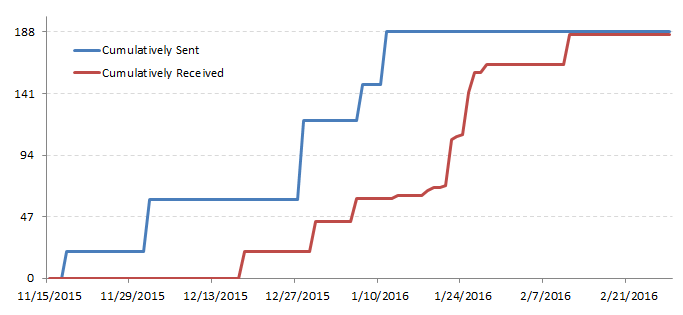
IHG surprised a lot of speculators in its delivery of the promotional game pieces as promised; the only deviation from the program terms was that most game pieces did not arrive within five days. But that’s a rather minor detail.
Verdict: win
FINAL THOUGHTS
Buying 14 speakers, a smartphone, and 188 stamps with no intention to keep any of them sounds to defy normal logic, yet it made sense in these unusual circumstances. For people who don’t already spend every waking moment thinking about points and miles (including a variety of cash back, of course), it can be hard to be comfortable with or excited about risky activities like these. As for me, I am grateful for these opportunities not only because they save me a bunch of money, but also because they make fun stories to tell.